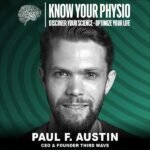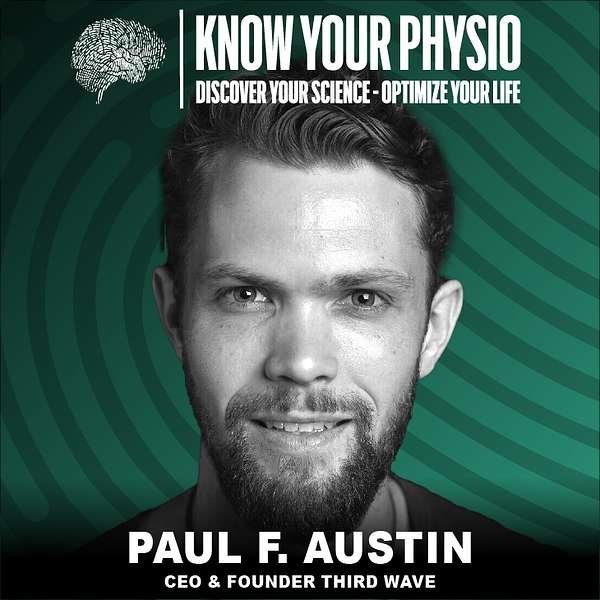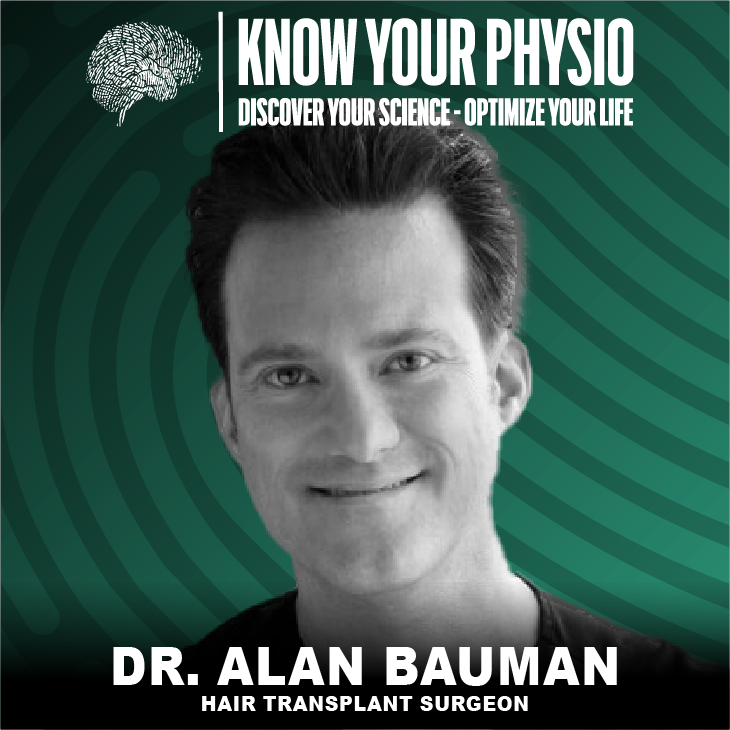
How Psychedelics Differ From Traditional Psychiatry

Imagine being able to access the deepest layers of your psyche, confront long-buried wounds, and emerge on the other side with clarity, peace, and a renewed sense of purpose. This is the transformative potential of psychedelics—compounds that are not only shaking up the mental health world but are also inspiring new paradigms in self-healing, growth, and connection.
Sleep Optimization in Sports and HRV InsightsHow to Unlock the DNA of Lifelong Wellness
From Symptom Management to Root Healing

Conventional psychiatry, for decades, has primarily focused on symptom management. Antidepressants, antipsychotics, and mood stabilizers often aim to rebalance neurotransmitters, offering temporary relief from conditions like depression or anxiety. But as Paul Austin points out, this method is inherently reductionist.
“Psychiatry is symptomatic, psychedelics get to the core of it.”
Unlike SSRIs or ADHD medications, which were modeled after gastrointestinal medicine (targeting a specific chemical imbalance), psychedelics address trauma and emotional blocks at their root. They work through the subconscious, unearthing deeply held patterns and unresolved emotional wounds.
This isn’t about taking a pill to feel slightly better—it’s about full psychological excavation. Psychedelics lift the veil on the stories we tell ourselves, confront us with truths we’ve avoided, and allow for a release that’s as emotional as it is energetic.
How Psychedelics Accelerate Inner Work

The Five Elements of a Transformative Psychedelic Journey
Paul Austin breaks down the psychedelic process into five essential elements:
- Assessment
Understanding personal history, mental health conditions, and readiness. - Preparation
Practices like meditation, journaling, yoga, or float tanks help ground individuals before diving into a deep experience. - Ceremony (The Experience)
This is the high-dose session, typically facilitated by a trusted guide, therapist, or coach. - Integration
Perhaps the most vital step, integration turns insight into tangible life changes. - Microdosing
Sub-perceptual doses taken regularly to sustain benefits over time and navigate life with clarity.
“A lot of people see the swimming pool of psychedelics and dive straight into the deep end. But if you haven’t learned to swim in the shallow end first, it’s dangerous.”
Austin uses the swimming metaphor to explain the importance of preparation. Just like you wouldn’t leap off a diving board without learning to swim, psychedelics demand foundational skills—stillness, self-awareness, and emotional openness.
Prerequisites for a Safe and Successful Experience
Before stepping into a psychedelic journey, there are key prerequisites:
- Curiosity & Openness: The desire must be authentic. Coercion, even from well-meaning loved ones, undermines the process.
- Willingness to Surrender: The experience may reveal suppressed trauma or discomforting truths.
- Contemplative Practice: Meditation, breathwork, or solitude teaches us to sit with discomfort—a vital skill when navigating the psychedelic terrain.
- Courage: Especially at high doses, courage is needed to face what arises without judgment.
“You need to be willing to go into the unknown, to not have all the answers.”
Andres Preschel, the host, echoes this sentiment by referencing a quote from Jim Kwik:
“You have to have the curiosity to get to know yourself and then the courage to be yourself.”
This blend of curiosity and courage is essential, especially when stepping into the uncharted waters of self-discovery.
Integration: Turning Insight into Lasting Transformation
The psychedelic experience doesn’t end when the effects wear off. In fact, that’s when the real work begins.
Integration is the process of translating revelations into everyday life. It’s about:
- Welcoming All Parts of the Self: Even those we’ve rejected due to shame or societal disapproval.
- Shadow Work: Looking at the repressed aspects of ourselves—unhealed wounds, limiting beliefs, and self-judgment—and bringing them into the light.
- Making Real-World Changes: Letting go of toxic behaviors, people, or environments and adopting healthier alternatives.
Paul shares a personal example:
“I played the violin as a kid. Where I grew up, that wasn’t seen as masculine. I rejected it for years. But now I’ve embraced it again—because that’s part of me.”
This is the essence of integration: making peace with every piece of who we are.
Avoiding Drastic Decisions Post-Trip

It’s not uncommon for individuals to emerge from a psychedelic experience ready to overhaul their entire lives. But Austin warns against acting too quickly.
“Wait 30 days before making any major life decisions.”
Focus is key. Pick one area of transformation—whether it’s ending a toxic relationship, changing a habit, or starting a new routine—and channel your renewed energy into that single change.
He also emphasizes the power of support systems. Coaches, therapists, or trained psychedelic facilitators can help guide the integration process, keep you accountable, and provide emotional safety as you shift and grow.
Healing Through Wholeness
Psychedelic integration is not about achieving perfection—it’s about embracing wholeness.
It’s the process of saying:
- I’m not broken.
- My wounds are part of my story.
- I can love and accept all aspects of myself.
This wholeness is deeply healing. Many of our struggles—addictions, depression, anxiety—stem from a fundamental lack of love, especially in early childhood. Psychedelics, particularly in a safe and guided setting, can offer a glimpse or even a full immersion into unconditional love.
“One of the reasons psychedelics are so healing is because people experience a sense of unconditional love for the first time in their lives.”
The Power of Facing the Shadow

One of the most misunderstood yet essential aspects of psychedelic healing is the concept of shadow work. Coined by Carl Jung, the “shadow” refers to the parts of ourselves that we suppress, hide, or deny—often because they were labeled unacceptable, shameful, or weak by parents, peers, or society.
Psychedelics have a way of shining a light on these disowned aspects of the self.
“Shadow work is shining a light into the repressed parts of my being… the parts I was told weren’t lovable or worthy.”
This is not about glorifying our flaws. It’s about recognizing them with compassion and curiosity instead of judgment. For many, the healing begins when they can finally say, “That happened. I felt that. It’s okay.”
The process is often emotional. Grief, anger, shame, and sadness may surface. But through this release, we create space. And in that space, we find freedom.
Choosing Who We Become

Healing through psychedelics isn’t just about looking back—it’s also about stepping forward. Many who experience this kind of transformation report a deep shift in identity. They gain clarity on:
- What matters most
- What no longer serves them
- Who they are becoming
But Austin emphasizes one thing above all: focus.
“If you try to do too much at once, all of it will fail.”
This is where integration meets discipline. With the brain’s increased neuroplasticity post-experience, it’s crucial to direct that rewiring toward a single, impactful change. Whether it’s cutting out sugar, ending a toxic relationship, or waking up earlier—choose one thing and commit.
The goal is not to become someone else but to become more authentically yourself.
The Responsibility of Choice

Psychedelics increase suggestibility—much like hypnosis. That’s why the container in which they’re used matters so much. Without a trustworthy guide, the vulnerability that makes psychedelics powerful can also become dangerous.
“Trust is the bedrock of healing. Without it, the work can’t go deep.”
In the wrong hands, that same suggestibility can be exploited. This is why the rise of psychedelic use demands ethical responsibility—not only from practitioners but from users as well.
Austin advises everyone considering a psychedelic experience to thoroughly vet their practitioner. Ask questions. Seek referrals. Make sure they offer preparation and integration support.
And most importantly: trust your intuition.
Guidelines for Choosing a Safe Psychedelic Practitioner
Here are some practical steps to ensure your guide or facilitator is trustworthy:
- Referral from a Trusted Friend or Family Member
Personal recommendations are gold. If someone you trust has had a positive experience, that’s a strong starting point. - Conduct an Interview
Any reputable guide will gladly answer your questions. Ask about:- Their intake/assessment process
- Preparation work
- Type and dosage of medicine
- Ceremony environment
- Integration support
- Microdosing knowledge
- Gauge Their Energy
Do you feel safe, seen, and supported when speaking with them? Do they genuinely listen? - Red Flags
- Refusal to answer questions
- Vague or evasive responses
- Pressure to take a certain dose
- No integration plan
Psychedelics vs. Psychopathy: A Nuanced Conversation

One of the more profound questions raised in the podcast was: What happens when someone with harmful tendencies—like narcissism or psychopathy—uses psychedelics? Can they be healed? Or will the experience worsen those tendencies?
Austin offers a candid and realistic take:
“Psychedelics may make psychopaths more psychopathic.”
This is a hard truth. These substances don’t inherently make someone good or kind—they amplify what’s already there. For someone lacking empathy or remorse, psychedelics can intensify manipulation, ego inflation, or delusions of grandeur.
He compares this to Charles Manson, who used LSD to manipulate his followers into committing horrific crimes.
But not all problematic behavior is rooted in psychopathy. Some people are simply unaware of the pain they cause—often shaped by their own unhealed wounds.
“The difference between someone who’s just an asshole and someone who’s psychopathic is self-awareness.”
If someone experiences a shift in self-awareness—a realization that their behavior is hurting others and a genuine desire to change—then psychedelics can be immensely helpful.
But again, intention and readiness are everything.
When Psychedelics Make You “That Person”

There’s a phenomenon common in psychedelic circles: the “evangelist.” Someone has a life-changing experience and suddenly wants everyone around them to do psychedelics too. They rave about it, post about it, preach about it, and eventually… become annoying.
“You become that person who won’t stop talking about ayahuasca.”
This enthusiasm comes from a good place—unconditional love is a powerful feeling. But Austin emphasizes the importance of restraint and discernment. Let your transformation speak for itself. Let people notice.
“Wait for the invitation.”
If someone asks you why you’re glowing, more energized, or more grounded—that’s your opportunity to share your journey in a meaningful way. But pushing it on others, especially those not ready or interested, can cause harm or misunderstanding.
Remember: psychedelics are not for everyone.
Who Are Psychedelics Really For?

There are generally two types of people who benefit most from psychedelic experiences:
- Those who are suffering deeply
Depression, addiction, trauma—people who feel like nothing else has worked. - The Seekers
Individuals on a path of self-discovery and growth. Curious, introspective, and committed to evolving.
These individuals approach psychedelics with respect and humility. They don’t see it as a party drug. They see it as a tool. A doorway. A teacher.
If you’re content with your life and feel no strong pull toward change, then psychedelics may not add much. But if you’re craving depth, transformation, or healing—they may be the key to unlocking your next level.
When Used with Intention, Psychedelics Can…
- Help process unresolved trauma
- Break cycles of addiction
- Improve relationships by increasing empathy
- Deepen your connection with your body and emotions
- Boost creativity and problem-solving
- Offer spiritual or existential clarity
- Create a profound sense of wholeness
But none of this happens passively. The work is yours to do.
Beyond Therapy: Psychedelics as Catalysts for a New Paradigm

Psychedelics are not just therapeutic tools—they are paradigm shifters. For many, the first encounter with a high-dose psychedelic experience initiates an entirely new way of relating to life, to others, and to themselves.
Paul Austin, drawing from years of experience in this realm, reminds us that these compounds are not merely to be used when we’re broken. They are instruments of transformation, not just treatment.
“I’m all for the therapeutic use… but I’m really keen on how psychedelics can help us create a new paradigm.”
In this evolving landscape, psychedelics are being embraced not only by individuals battling PTSD or addiction but also by leaders, creatives, and entrepreneurs—those seeking to elevate consciousness, innovate authentically, and lead with empathy.
The transformative power of psychedelics lies in their ability to reset our internal compass. They help us remember what matters. They show us the cost of disconnection—from nature, from others, and from our true selves.
The Physiology of Psychedelic Healing
Let’s move from the mystical to the tangible—what actually happens in the body when we take psychedelics?
Austin explains how modern medicine has often separated the brain from the body. Psychiatry, for instance, evolved with a reductionist lens—treating the brain like the gut: target the symptom, manipulate a neurotransmitter, and hope for the best.
But the brain isn’t a silo. It’s an extension of the body’s intelligence, deeply intertwined with our emotional and somatic experiences. Psychedelics reunite the body and mind, often in a deeply felt, visceral way.
“There’s only so much we can intellectually unwind when it comes to trauma. Some trauma is stored in the body. The only way to access it is through altered states.”
Accessing the Subconscious Through the Body
Trauma is often stored in the fascia, muscles, and nervous system. Psychedelic compounds like ketamine allow practitioners to access these hidden layers.
Austin shares a powerful experience where ketamine, combined with transformational bodywork, enabled a deep physical release that would have been too painful otherwise.
This integration of psychedelic therapy with somatic modalities—bodywork, breathwork, movement—is a growing trend. It acknowledges that emotional healing isn’t just about crying it out. Sometimes it’s about shaking, stretching, sweating, or sobbing through decades of suppressed experience.
Why Now? Psychedelics and Our Evolutionary Relationship

One of the most fascinating questions that emerges is: Why do these compounds affect us so profoundly? Why do mushrooms, cacti, and vines produce substances that catalyze such deep human transformation?
There are no definitive answers—but there are compelling theories.
The Stoned Ape Hypothesis
Popularized by ethnobotanist Terence McKenna, the Stoned Ape Theory posits that early hominids who consumed psilocybin mushrooms gained a survival advantage. Enhanced visual acuity, improved empathy, and cognitive expansion may have accelerated human evolution.
While speculative, the theory aligns with archaeological and anthropological findings that suggest humans have used psychoactive substances for thousands of years, across all cultures and continents.
From the Eleusinian Mysteries in Ancient Greece to the Soma rituals of Vedic India, from Mayan mushroom stones to Amazonian ayahuasca ceremonies, humanity has always maintained a relationship with altered states.
“We’ve become so disconnected from our human essence… and psychedelics give us hope.”
This is not new. What’s new is our collective readiness to reclaim it.
Psychedelics in Modern Society: Hope for a New System

Our systems—healthcare, education, politics, environment—are showing signs of breakdown. Many people feel it: the overwhelm, the anxiety, the dread.
And yet, amidst the chaos, psychedelics are rising.
They offer more than just individual healing. They offer a shift in perspective—from competition to collaboration, from extraction to regeneration, from fear to love.
“It’s our generation’s duty to create new paradigms… rooted in interconnectedness.”
Psychedelics may be the bridge. Not just to better mental health—but to better systems. More compassionate leaders. More conscious decisions. More courageous action.
Psychedelics and the Fear of Death

One of the most universal human fears is death. And yet, one of the most common outcomes of a profound psychedelic experience is a peaceful, even joyful, relationship with death.
In fact, studies have shown that psychedelics can:
- Reduce end-of-life anxiety in terminal patients
- Increase spiritual well-being
- Dissolve the ego’s grip on the fear of non-existence
“What psychedelics help us learn is that life will go on. Death is not to be feared.”
This doesn’t just change how we die—it changes how we live.
When we no longer fear death, we make bolder choices. We express more freely. We love more fully. We stop wasting time on things that don’t matter.
How to Begin

If this all feels inspiring but overwhelming, here are practical steps for those curious about exploring psychedelics safely and intentionally:
- Educate Yourself
Read, listen, research. nderstand the science,, history, and cultural significance. - Reflect on Your Intentions
Are you seeking healing? Clarity? Connection? Know your “why.” - Start with Microdosing (if legal)
Microdosing can be a gentle, safe entry point to experience subtle benefits. - Vet Your Guide Thoroughly
As covered earlier, make sure your practitioner offers assessment, preparation, ceremony, and integration. - Don’t Rush
This is not a race. Let the journey unfold at your pace. There’s no rush to dive into a high-dose ceremony if you’re not ready. - Integrate with Intention
The insights are just the beginning. The magic lies in the integration—changing habits, choosing presence, and living more authentically.
Frequently Asked Questions (FAQs)
Q1: Are psychedelics safe for everyone?
No. Individuals with a history of psychosis, schizophrenia, or certain heart conditions should avoid psychedelics. Always consult a medical or mental health professional beforehand.
Q2: Is microdosing legal?
Laws vary by country and state. Some psychedelics are decriminalized or allowed in clinical trials, but many are still illegal. Do your research before proceeding.
Q3: Can psychedelics cause bad trips?
Yes, challenging experiences are possible—especially without proper set, setting, or intention. However, these experiences can also be valuable and transformative when integrated well.
Q4: How long do the effects last?
It depends on the substance. Psilocybin (magic mushrooms) lasts 4–6 hours, LSD 8–12 hours, and ayahuasca around 4–8 hours. The integration process, however, can last weeks or months.
Q5: Can I do this alone?
While some solo journeys are safe and insightful, beginners are strongly advised to work with a trained guide or join a trusted retreat for safety and support.
Final Thoughts
The transformative power of psychedelics lies not in escaping life—but in returning to it more whole, more aware, and more aligned. These substances are not a cure-all, but they are a call to presence. They’re an invitation to remember who we are and to reclaim the parts we’ve hidden, forgotten, or rejected.
This is not the easy path—but it may just be the most rewarding one.
And in the words of Paul Austin…
“This could be your last day. Life is a gift. Make the most of it.”




